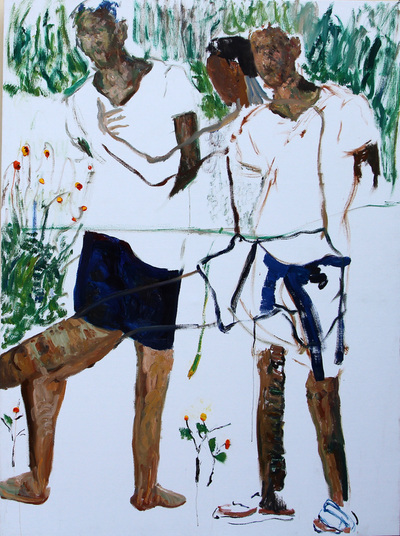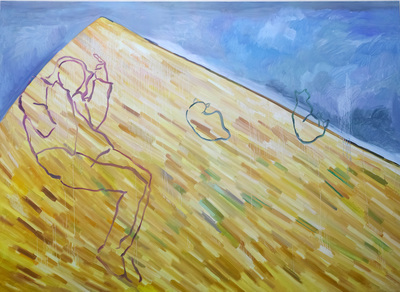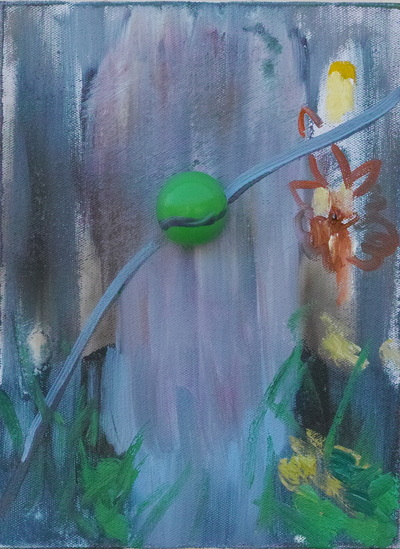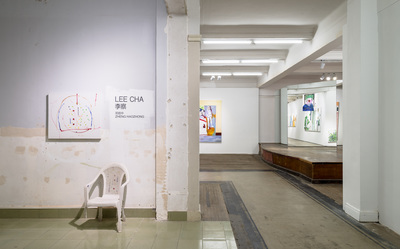LEE CHA / 李察
Zheng Haozhong 郑皓中
Curator/策展人: Jessie Xie 谢玮玲
Opening:2016.01.16, 4pm - 6pm
Duration:2016.01.16-2016.03.12
Address:BANK 1/F, 59 Xianggang Lu, Shanghai, China
Opening Hours: Tuesdays to Sundays, 10:30am - 6:30pm [email protected]
开幕酒会:2016.01.16, 4pm - 6pm
展期:2016.01.16-2016.03.12
地址:BANK 中国上海市黄浦区香港路59号1楼
开放时间:每周二至周日上午10点半至下午6点半 [email protected]
Introduction by Curator | 策展人文
Who is Lee Cha?
Without a doubt, this character “Lee Cha” should be the protagonist of this exhibition. Although storyboard or comic strip-like formal separations often appear in artist Zheng Haozhong’s paintings, they offer no clear or logical narrative. From these linearly divided compositions, we can only intermittently discern certain figural shapes, postures, personalities, and scenarios derived therein. Through this we gather various characteristics and clues related to the identity of “Lee Cha,” from his life’s physical routine to an ineffable, hidden consciousness, provoking us to consider whether this figure “Lee Cha” is actually real, or fictional.
The majority of the exhibition’s destructive tableaus are drawn from life. The creator lives in a small, coastal town. His work largely relies on this natural environment, as well as the few friends and relatives around him with whom he is close. He has built a small, carefree world with himself as the absolute center. This lifestyle, a certain contentment in mastering one’s small lot, and a painting practice built on a sense of trust are perhaps shackles to his work. And yet the artist does achieve a certain relative freedom in this.
This freedom is manifest in his mastery of the picture plane itself—what can remain, what can be abandoned. The artist seizes upon dynamic changes that happen on site, from a model who momentarily stands up, to the sprouting and withering of a tree’s leaves throughout the year. Through his choices and adjustments on the canvas, everything seems masterfully handled. Academic training has familiarized him with the relationships between line and plane, positive and negative space, abstraction and realism, looseness and restraint. Some works seem as if they were made in one stretch. However, each of these pieces takes into account factors of time, temperature, perspective, and other considerations, recombining different dimensions of external appearance on the same canvas that ultimately evolves into a perfect accident. Stripping away its fractured skin, his painting is like a process of painstaking cultivation, maintaining a state that is closest to true nature. Outside of the artist’s plans, he also embraces a delightful sense of chance, yet still the composition, resonance, and layering of the different elements also abides by certain principles. The work ultimately grows into a reasonable conclusion, giving off a certain palpable sense of ease and maturity.
On the other hand, at times this freedom is also manifest in the artist’s private verdict of certain targeted judgments. For instance, he will find some excuse to paint a clothed model nude or dress a man in a woman’s pink outfit. In the last work of his series “Qiu Chen”, Zheng had a falling out with his close friend and, feeling at a loss, decided to burn Qiu Chen’s hair in the painting as an act of revenge. The model’s sudden departure, leaving the artist to a situation in which all that remained was the artist himself, provided Zheng with an opportunity to investigate the self, even if it was a last resort. In this series of paintings the artist seemingly strives to defend himself: either by way of tender monologue or intense interrogation, they oscillate between narrative and unconscious rambling.
What these fragmentary works collectively foreshadow is not merely the image of some “other” from the artist’s everyday life--a powerful “ego” can’t restrain itself from encroaching and controlling. Always partly hidden and partly visible, spanning throughout its entirety, the ego evitably pushes the viewer’s attention toward the nature that underlies all intent. This includes the artist himself. What’s interesting is that this inward observation perhaps originates in a narcissistic love and adoration. The mirror has replaced the water’s surface, realizing a series of slightly affected self-portraits. However, compared to the phantom in the mirror, the most truly engaging self-evaluation exists within the circuit of interactions between the artist and the small world he has delineated for himself. It is an ego hijacked by an unavoidable reflexive power, as if laid beneath the pale, glaring, shadowless lamp of an operating room, naked and dialyzing all the minutiae of the spirit beneath the skin, including those lesions that have already infected the marrow. Humanity’s pride, indolence, servility, and cowardice have created a situation in which self-perception is like an arduous march forward in shackles.
Even more unfortunate, the perceptions and thoughts born from all these paths are treasures that belong to Zheng Haozhong alone; painting is thus a form of squandering. Stemming from a superstitious belief in insinuation and metaphor, we can only rely on the strange and mysterious images within the artworks to guess at the impulses that drive them. Nietzsche’s emphasis on the instinctive ability of the unconscious, Freud’s theory that “the unconscious is the true psychical reality,” Jung’s profound belief that psychic phenomenon must necessarily adhere to laws outside of the laws of physics—all could be used as footnotes to Zheng’s painterly rhetoric. Religious symbols evocative of “pentagram worship” and augury allow the painted image to break free from everyday experience and memory, slipping into the more profound and unpredictable “collective unconscious.” The artist eliminates dependence upon physical time and banal space, taking the world of images through the gash he has torn open. That uncontrolled ignorance forever inspires fear and intimidation, as if the artist one day discovered he faced a shattering mirror. As with countless other paralyzing occurrences, and all he can do is ascribe them to fate and cast them into the underworld.
People no longer feel a sense of curiosity when faced with familiar things. When absence arises they are far more able to capture the gaze, and from there the divine appears as reality. The excitement of reading an artwork is because, in that moment, it is as if we have collided with a mysterious and true instinct that lies hidden in that which comes after. “Lee Cha” is both a figure in the painting and the figure who paints. He is constantly reborn, yet he cannot break from the past. This exhibition is only a beginning, letting us first meet this man named “Lee Cha.”
Zheng Haozhong (b. 1985) graduated from the China Central Academy of Fine Arts in 2008. Today he lives and works in Rizhao, Shandong. In 2014 he won First Prize in the John Moores Painting Prize (China). His winning painting was exhibited in the National Museums Liverpool and later shown in Beijing, Macau, and Shanghai, among other cities. After his first solo exhibition at BANK, the artist will hold another solo show at the Centre for Chinese Contemporary Art in Manchester in mid-2016, supported by the DSL Collection.
Zheng Haozhong has also published novels online under the pseudonym “Lee Cha.”
“李察”是谁?
毫无疑问,这个叫“李察”的人理应是此次展览的主角。虽然艺术家郑皓中的绘画作品中多次出现分镜头或连环画般的分格形式,但却并未提供出一段清晰地、符合惯常逻辑的叙述。我们只能从这些被线条径直分割的构图中,断断续续地辨认出一些人物的外型、姿势、性格,及衍生出的情节,以此收集关于“李察”这一身份的各种属性和线索,从生活中的物理作息,到难以言说的隐秘意识,开启对于“李察”这一人物究竟是真实还是虚构的考量。
展览中这些极具破坏力的画面大多却是在写生状态下完成的。艺术家生活在一个滨海小城,创作极大地依赖于其所处的自然环境,及周边少数几位与之熟悉的家人和朋友。他以自身为绝对中心构建起令其安心的小世界。几近偏安一隅的生活方式,和必须建立在信任之上的绘画对于创作来说或许是一种桎梏,但他的确也在其中获得了某种相对的自由。
这种自由体现在对于画面本身的掌控中——什么可以留存什么可以放弃。画家捕捉现场发生的动态变化,从一瞬间随意起身的模特,到一年之中树叶的新生枯败,在画布上加以选择和调整,一切都似乎应付自如。学院教育使其深谙线与面、空与满、抽象与写实、松弛和克制的关系。有些看似一气呵成的结果,却是经历了时间、温度、视角等等的转变,把不同维度下的外在呈现重构于同一张画布上,最终演变成一场完美的事故。剥去看似支离破碎的表皮,其绘画却如同一个精心栽种的过程,保持着最贴近真实自然的状态。其中计划外的偶然性出现着实叫人欣喜,但同时元素之间的组成、呼应或叠加亦遵循着一定的法则,最终成长为一种合理的结果,释放出正待收割的成熟与洒脱。
而在另外一方面,自由有时又体现在艺术家于画面上私自实施地对于目标的裁决,例如藉由某种借口把穿衣的模特画成裸体,或着给男人换上女人的粉色衣服。在《邱晨》系列的最后一幅作品中,郑皓中对于挚友的突然决裂无所适从,选择在画面中报复性地燃烧邱晨的头发。模特的不告而别将艺术家丢弃在一个只剩下自己的现实境遇中,反倒给予了他一个在绘画里追究自我的机会,尽管很大程度上是出于一种不得已。作品似乎是他尽力为自己所做的辩护:或是温情的独白,或是激烈的诘问,徘徊在叙说与无意识的喃喃自语之间。
此时,这些片段式的作品集体勾勒出的已经不仅仅是日常中的某一个他者形象,一个强权的“我”难以抑制地侵略并操控着画面,始终若隐若现,贯穿其中,难免使人将注意力转向所有心理意图背后的本性。这其中也包括艺术家自己。有趣的是,这种向内的观察或许最初始于纳西索斯式的崇拜和爱恋,镜子取代了水面,成就了创作者一幅幅略带矫饰的自画像。然而比起镜子中的幻像,真正令人琢磨至深的自审,存在于他与自己亲手圈定的小世界相处的回路中。无法避及的反身力量所挟持下的自我,就像是被搁在了手术室苍白刺眼的无影灯下,赤裸裸地透析出皮囊之下关乎灵魂的细枝末节,包括那些已侵入骨髓的病变。人类的傲慢、懒惰、屈从和懦弱造成了对于自我的认知永远像是在黑暗中带着脚镣艰难前行。
更为可惜的是,所有路途中伴生的感知和思想,只能是属于郑皓中自己的瑰宝,绘画即是一种挥霍。出于对暗示和隐喻的迷信,我们只能依据作品中那些诡异而神秘的形象来猜测其背后的驱动力。尼采对于无意识和本能的推崇,弗洛伊德关于“无意识才是精神的真正实际”的学说,荣格所深信的心理现象必然遵循着一种有别于物理法则的法则,都可以拿来作为郑皓中绘画语言的注脚。那些令人联想到“芒星崇拜”和占卜术的心理符号,使得绘画形象从日常经验和记忆中挣脱出来,滑向更加深不可测的“集体潜意识”。艺术家破坏了对于物理时间和空间平庸的依附,从划开的口子里,完成了对表像世界的僭越。不为人所控的那部分未知永远令人好奇而生畏,就好像当某一天艺术家发现面对哐当而碎的镜子,及其它许许多多的发生都无能为力时,只能把其中的大部分归结于命运并将之抛向冥冥之中。
人们对于可辨的事物已经提不起任何好奇心,而当缺席产生,反而能获得更多的凝视,神性继而栩栩如生。阅读作品所带来的兴奋,是因为我们似乎有那么一瞬间触碰到了隐藏在那之后的神秘而真实的本能。“李察”既是绘画中的人,也是绘画的人。他不断地新生,亦摆脱不了往昔。此次展览只是一个开始,且让我们先来认识一下,这个叫“李察”的人。
—————--
郑皓中,1985年出生,2008年毕业于中央美术学院,目前生活在山东日照。曾获得2014年约翰莫尔绘画比赛(中国)大奖,作品展出于英国利物浦国家美术馆,并巡展于北京、澳门、上海等地。此次BANK的首次个展后,艺术家将于2016年中由法国DSL基金会支持在英国曼彻斯特华人艺术中心举办个展。郑皓中曾以“李察”为笔名在网络上发表小说。
Zheng Haozhong 郑皓中
Curator/策展人: Jessie Xie 谢玮玲
Opening:2016.01.16, 4pm - 6pm
Duration:2016.01.16-2016.03.12
Address:BANK 1/F, 59 Xianggang Lu, Shanghai, China
Opening Hours: Tuesdays to Sundays, 10:30am - 6:30pm [email protected]
开幕酒会:2016.01.16, 4pm - 6pm
展期:2016.01.16-2016.03.12
地址:BANK 中国上海市黄浦区香港路59号1楼
开放时间:每周二至周日上午10点半至下午6点半 [email protected]
Introduction by Curator | 策展人文
Who is Lee Cha?
Without a doubt, this character “Lee Cha” should be the protagonist of this exhibition. Although storyboard or comic strip-like formal separations often appear in artist Zheng Haozhong’s paintings, they offer no clear or logical narrative. From these linearly divided compositions, we can only intermittently discern certain figural shapes, postures, personalities, and scenarios derived therein. Through this we gather various characteristics and clues related to the identity of “Lee Cha,” from his life’s physical routine to an ineffable, hidden consciousness, provoking us to consider whether this figure “Lee Cha” is actually real, or fictional.
The majority of the exhibition’s destructive tableaus are drawn from life. The creator lives in a small, coastal town. His work largely relies on this natural environment, as well as the few friends and relatives around him with whom he is close. He has built a small, carefree world with himself as the absolute center. This lifestyle, a certain contentment in mastering one’s small lot, and a painting practice built on a sense of trust are perhaps shackles to his work. And yet the artist does achieve a certain relative freedom in this.
This freedom is manifest in his mastery of the picture plane itself—what can remain, what can be abandoned. The artist seizes upon dynamic changes that happen on site, from a model who momentarily stands up, to the sprouting and withering of a tree’s leaves throughout the year. Through his choices and adjustments on the canvas, everything seems masterfully handled. Academic training has familiarized him with the relationships between line and plane, positive and negative space, abstraction and realism, looseness and restraint. Some works seem as if they were made in one stretch. However, each of these pieces takes into account factors of time, temperature, perspective, and other considerations, recombining different dimensions of external appearance on the same canvas that ultimately evolves into a perfect accident. Stripping away its fractured skin, his painting is like a process of painstaking cultivation, maintaining a state that is closest to true nature. Outside of the artist’s plans, he also embraces a delightful sense of chance, yet still the composition, resonance, and layering of the different elements also abides by certain principles. The work ultimately grows into a reasonable conclusion, giving off a certain palpable sense of ease and maturity.
On the other hand, at times this freedom is also manifest in the artist’s private verdict of certain targeted judgments. For instance, he will find some excuse to paint a clothed model nude or dress a man in a woman’s pink outfit. In the last work of his series “Qiu Chen”, Zheng had a falling out with his close friend and, feeling at a loss, decided to burn Qiu Chen’s hair in the painting as an act of revenge. The model’s sudden departure, leaving the artist to a situation in which all that remained was the artist himself, provided Zheng with an opportunity to investigate the self, even if it was a last resort. In this series of paintings the artist seemingly strives to defend himself: either by way of tender monologue or intense interrogation, they oscillate between narrative and unconscious rambling.
What these fragmentary works collectively foreshadow is not merely the image of some “other” from the artist’s everyday life--a powerful “ego” can’t restrain itself from encroaching and controlling. Always partly hidden and partly visible, spanning throughout its entirety, the ego evitably pushes the viewer’s attention toward the nature that underlies all intent. This includes the artist himself. What’s interesting is that this inward observation perhaps originates in a narcissistic love and adoration. The mirror has replaced the water’s surface, realizing a series of slightly affected self-portraits. However, compared to the phantom in the mirror, the most truly engaging self-evaluation exists within the circuit of interactions between the artist and the small world he has delineated for himself. It is an ego hijacked by an unavoidable reflexive power, as if laid beneath the pale, glaring, shadowless lamp of an operating room, naked and dialyzing all the minutiae of the spirit beneath the skin, including those lesions that have already infected the marrow. Humanity’s pride, indolence, servility, and cowardice have created a situation in which self-perception is like an arduous march forward in shackles.
Even more unfortunate, the perceptions and thoughts born from all these paths are treasures that belong to Zheng Haozhong alone; painting is thus a form of squandering. Stemming from a superstitious belief in insinuation and metaphor, we can only rely on the strange and mysterious images within the artworks to guess at the impulses that drive them. Nietzsche’s emphasis on the instinctive ability of the unconscious, Freud’s theory that “the unconscious is the true psychical reality,” Jung’s profound belief that psychic phenomenon must necessarily adhere to laws outside of the laws of physics—all could be used as footnotes to Zheng’s painterly rhetoric. Religious symbols evocative of “pentagram worship” and augury allow the painted image to break free from everyday experience and memory, slipping into the more profound and unpredictable “collective unconscious.” The artist eliminates dependence upon physical time and banal space, taking the world of images through the gash he has torn open. That uncontrolled ignorance forever inspires fear and intimidation, as if the artist one day discovered he faced a shattering mirror. As with countless other paralyzing occurrences, and all he can do is ascribe them to fate and cast them into the underworld.
People no longer feel a sense of curiosity when faced with familiar things. When absence arises they are far more able to capture the gaze, and from there the divine appears as reality. The excitement of reading an artwork is because, in that moment, it is as if we have collided with a mysterious and true instinct that lies hidden in that which comes after. “Lee Cha” is both a figure in the painting and the figure who paints. He is constantly reborn, yet he cannot break from the past. This exhibition is only a beginning, letting us first meet this man named “Lee Cha.”
Zheng Haozhong (b. 1985) graduated from the China Central Academy of Fine Arts in 2008. Today he lives and works in Rizhao, Shandong. In 2014 he won First Prize in the John Moores Painting Prize (China). His winning painting was exhibited in the National Museums Liverpool and later shown in Beijing, Macau, and Shanghai, among other cities. After his first solo exhibition at BANK, the artist will hold another solo show at the Centre for Chinese Contemporary Art in Manchester in mid-2016, supported by the DSL Collection.
Zheng Haozhong has also published novels online under the pseudonym “Lee Cha.”
“李察”是谁?
毫无疑问,这个叫“李察”的人理应是此次展览的主角。虽然艺术家郑皓中的绘画作品中多次出现分镜头或连环画般的分格形式,但却并未提供出一段清晰地、符合惯常逻辑的叙述。我们只能从这些被线条径直分割的构图中,断断续续地辨认出一些人物的外型、姿势、性格,及衍生出的情节,以此收集关于“李察”这一身份的各种属性和线索,从生活中的物理作息,到难以言说的隐秘意识,开启对于“李察”这一人物究竟是真实还是虚构的考量。
展览中这些极具破坏力的画面大多却是在写生状态下完成的。艺术家生活在一个滨海小城,创作极大地依赖于其所处的自然环境,及周边少数几位与之熟悉的家人和朋友。他以自身为绝对中心构建起令其安心的小世界。几近偏安一隅的生活方式,和必须建立在信任之上的绘画对于创作来说或许是一种桎梏,但他的确也在其中获得了某种相对的自由。
这种自由体现在对于画面本身的掌控中——什么可以留存什么可以放弃。画家捕捉现场发生的动态变化,从一瞬间随意起身的模特,到一年之中树叶的新生枯败,在画布上加以选择和调整,一切都似乎应付自如。学院教育使其深谙线与面、空与满、抽象与写实、松弛和克制的关系。有些看似一气呵成的结果,却是经历了时间、温度、视角等等的转变,把不同维度下的外在呈现重构于同一张画布上,最终演变成一场完美的事故。剥去看似支离破碎的表皮,其绘画却如同一个精心栽种的过程,保持着最贴近真实自然的状态。其中计划外的偶然性出现着实叫人欣喜,但同时元素之间的组成、呼应或叠加亦遵循着一定的法则,最终成长为一种合理的结果,释放出正待收割的成熟与洒脱。
而在另外一方面,自由有时又体现在艺术家于画面上私自实施地对于目标的裁决,例如藉由某种借口把穿衣的模特画成裸体,或着给男人换上女人的粉色衣服。在《邱晨》系列的最后一幅作品中,郑皓中对于挚友的突然决裂无所适从,选择在画面中报复性地燃烧邱晨的头发。模特的不告而别将艺术家丢弃在一个只剩下自己的现实境遇中,反倒给予了他一个在绘画里追究自我的机会,尽管很大程度上是出于一种不得已。作品似乎是他尽力为自己所做的辩护:或是温情的独白,或是激烈的诘问,徘徊在叙说与无意识的喃喃自语之间。
此时,这些片段式的作品集体勾勒出的已经不仅仅是日常中的某一个他者形象,一个强权的“我”难以抑制地侵略并操控着画面,始终若隐若现,贯穿其中,难免使人将注意力转向所有心理意图背后的本性。这其中也包括艺术家自己。有趣的是,这种向内的观察或许最初始于纳西索斯式的崇拜和爱恋,镜子取代了水面,成就了创作者一幅幅略带矫饰的自画像。然而比起镜子中的幻像,真正令人琢磨至深的自审,存在于他与自己亲手圈定的小世界相处的回路中。无法避及的反身力量所挟持下的自我,就像是被搁在了手术室苍白刺眼的无影灯下,赤裸裸地透析出皮囊之下关乎灵魂的细枝末节,包括那些已侵入骨髓的病变。人类的傲慢、懒惰、屈从和懦弱造成了对于自我的认知永远像是在黑暗中带着脚镣艰难前行。
更为可惜的是,所有路途中伴生的感知和思想,只能是属于郑皓中自己的瑰宝,绘画即是一种挥霍。出于对暗示和隐喻的迷信,我们只能依据作品中那些诡异而神秘的形象来猜测其背后的驱动力。尼采对于无意识和本能的推崇,弗洛伊德关于“无意识才是精神的真正实际”的学说,荣格所深信的心理现象必然遵循着一种有别于物理法则的法则,都可以拿来作为郑皓中绘画语言的注脚。那些令人联想到“芒星崇拜”和占卜术的心理符号,使得绘画形象从日常经验和记忆中挣脱出来,滑向更加深不可测的“集体潜意识”。艺术家破坏了对于物理时间和空间平庸的依附,从划开的口子里,完成了对表像世界的僭越。不为人所控的那部分未知永远令人好奇而生畏,就好像当某一天艺术家发现面对哐当而碎的镜子,及其它许许多多的发生都无能为力时,只能把其中的大部分归结于命运并将之抛向冥冥之中。
人们对于可辨的事物已经提不起任何好奇心,而当缺席产生,反而能获得更多的凝视,神性继而栩栩如生。阅读作品所带来的兴奋,是因为我们似乎有那么一瞬间触碰到了隐藏在那之后的神秘而真实的本能。“李察”既是绘画中的人,也是绘画的人。他不断地新生,亦摆脱不了往昔。此次展览只是一个开始,且让我们先来认识一下,这个叫“李察”的人。
—————--
郑皓中,1985年出生,2008年毕业于中央美术学院,目前生活在山东日照。曾获得2014年约翰莫尔绘画比赛(中国)大奖,作品展出于英国利物浦国家美术馆,并巡展于北京、澳门、上海等地。此次BANK的首次个展后,艺术家将于2016年中由法国DSL基金会支持在英国曼彻斯特华人艺术中心举办个展。郑皓中曾以“李察”为笔名在网络上发表小说。




































